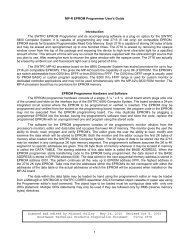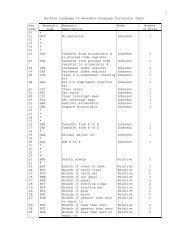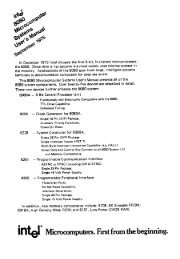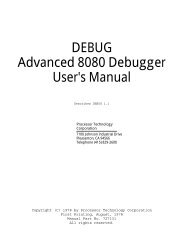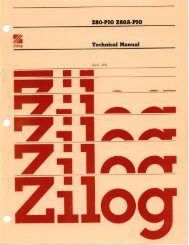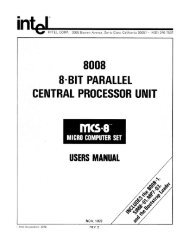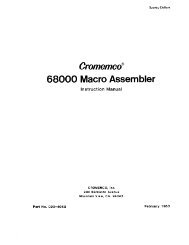The System Manual of SOL-20 - History of Computers
The System Manual of SOL-20 - History of Computers
The System Manual of SOL-20 - History of Computers
You also want an ePaper? Increase the reach of your titles
YUMPU automatically turns print PDFs into web optimized ePapers that Google loves.
PROCESSOR TECHNOLOGY CORPORATION<br />
Sol THEORY OF OPERATION<br />
SECTION VIII<br />
<strong>The</strong> inverted DBIN on pin 3 <strong>of</strong> U46 is also applied to pin 12<br />
<strong>of</strong> NOR gate U46 and inverted to appear as PDBIN on S-100 Bus pin 78.<br />
This section <strong>of</strong> U46 also allows !DIG1 (bus pin 57) to override DBIN.<br />
(!DIG1 is used when an external DMA device replaces the CPU in terms<br />
<strong>of</strong> writing into and reading from memory.) <strong>The</strong> other CPU control signals<br />
(SYNC, INTE, HLDA, WR and WAIT) are also fed to the S-100 Bus<br />
pins as indicated. <strong>The</strong>se, as well as DBIN or !DIG1, are placed on the<br />
bus through tri-state drivers which are enabled by C/C DSB on S-100<br />
Bus pin 19. Note that this signal is normally pulled high by R<strong>20</strong>.<br />
<strong>The</strong> data lines <strong>of</strong> the CPU (D0-7) are bidirectional and are<br />
used for several functions. One <strong>of</strong> these is to output status at the<br />
start <strong>of</strong> each cycle which is marked by the SYNC output <strong>of</strong> the CPU.<br />
Status on D0-7 is latched in U93 and U106 (each <strong>of</strong> which contains<br />
four D flip-flops) when pin 8 <strong>of</strong> inverter U45 goes high. Status information,<br />
as identified on the schematic, is then buffered through<br />
tri-state drivers U94 and U107 to the S-100 Bus. <strong>The</strong> status latch<br />
strobe on pin 8 <strong>of</strong> U45 is extracted in the middle <strong>of</strong> the SYNC pulse<br />
by gating PSYNC and !φ2 in NAND gate U44. !STAT_DSB on S-100 Bus pin<br />
18 is used to disable the U94 and U107 buffers when a DMA device or<br />
another processor assumes control <strong>of</strong> the S-100 Bus.<br />
A second function <strong>of</strong> D0-7 is to output data from the CPU to<br />
the Bidirectional Data Bus. Data out <strong>of</strong> the CPU is placed on this<br />
bus through tri-state drivers (U80 and U81). Note that these drivers<br />
are normally enabled unless this bus is in the input mode or an external<br />
device has control <strong>of</strong> the bus. In the latter case, !DO_DSB on<br />
S-100 Bus pin 23 would be pulled low to make pin 8 <strong>of</strong> NOR gate U48<br />
high. In the input mode pin 8 <strong>of</strong> U48 is high because !OUT_DSB is low.<br />
This signal is generated by decoding !PAGE_CC, MEM_SEL, !PORT_IN_FC,<br />
PORT_IN_FD, INT_SEL to produce MPX_ADR_A and MPX_ADR_B on pins 3 and<br />
11 respectively <strong>of</strong> two NOR gates in U48. MPX_ADR_A and MPX_ADR_B are<br />
decoded with !DBIN on pin 5 <strong>of</strong> NAND gate U47.<br />
<strong>The</strong> D0-7 bus lines are also used to input data to the CPU.<br />
Data input to the CPU is multiplexed from four data buses with four<br />
4-to-l line multiplexers (U65, 66, 70 and 79). <strong>The</strong>se four buses are<br />
the: 1) Keyboard Data Bus, KDB0-7, 2) Parallel Input Data Bus,<br />
PID0-7, 3) Internal Data Bus, INT0-7, and 4) Bidirectional Data Bus,<br />
DIO0-7.<br />
<strong>The</strong>se data multiplexers are tri-state devices, with their<br />
outputs pulled up by R107 through R114 to a level that satisfies the<br />
input requirements <strong>of</strong> the CPU. <strong>The</strong>ir outputs are active only when<br />
both their El and E2 (pins 1 and 15) are low. As can be seen, this<br />
occurs only when !DBIN on pin 3 <strong>of</strong> NOR gate U46 is low; that is, when<br />
the DBIN output <strong>of</strong> the CPU is active to indicate its data bus is in<br />
the input mode.<br />
VIII-13



